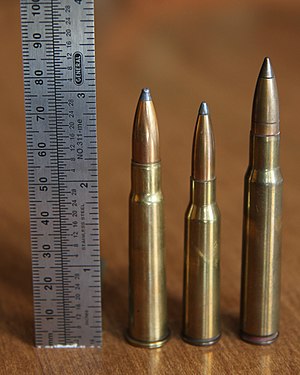| .303 British | ||||||||||||||||
|---|---|---|---|---|---|---|---|---|---|---|---|---|---|---|---|---|
 | ||||||||||||||||
| Type | Rifle | |||||||||||||||
| Place of origin | United Kingdom | |||||||||||||||
| Service history | ||||||||||||||||
| In service | 1889–present | |||||||||||||||
| Used by | United Kingdom and many other countries | |||||||||||||||
| Wars |
| |||||||||||||||
| Production history | ||||||||||||||||
| Produced | 1889–present | |||||||||||||||
| Specifications | ||||||||||||||||
| Case type | Rimmed, tapered, bottleneck | |||||||||||||||
| Bullet diameter | 7.92 mm (0.312 in) | |||||||||||||||
| Land diameter | 7.70 mm (0.303 in) | |||||||||||||||
| Neck diameter | 8.64 mm (0.340 in) | |||||||||||||||
| Shoulder diameter | 10.19 mm (0.401 in) | |||||||||||||||
| Base diameter | 11.68 mm (0.460 in) | |||||||||||||||
| Rim diameter | 13.72 mm (0.540 in) | |||||||||||||||
| Rim thickness | 1.63 mm (0.064 in) | |||||||||||||||
| Case length | 56.44 mm (2.222 in) | |||||||||||||||
| Overall length | 78.11 mm (3.075 in) | |||||||||||||||
| Case capacity | 3.64 cm3 (56.2 gr H2O) | |||||||||||||||
| Rifling twist | 254 mm (1-10 in) | |||||||||||||||
| Primer type | Large rifle | |||||||||||||||
| Maximum pressure (C.I.P.) | 365.00 MPa (52,939 psi) | |||||||||||||||
| Maximum pressure (SAAMI) | 337.84 MPa (49,000 psi) | |||||||||||||||
| Maximum CUP | 45,000 CUP | |||||||||||||||
| Ballistic performance | ||||||||||||||||
| ||||||||||||||||
| Test barrel length: 24 in (610 mm) Source(s): Accurate Powder[1][failed verification] | ||||||||||||||||
The .303 British (designated as the 303 British by the C.I.P.[2] and SAAMI[3]) or 7.7×56mmR, is a .303-inch (7.7 mm) calibre rimmed tapered rifle cartridge. The .303 inch bore diameter is measured between rifling lands as is the common practice in Europe which follows the traditional black powder convention.
It was first manufactured in Britain as a stop-gap black powder round put into service in December 1888 for the Lee–Metford rifle. From 1891 the cartridge used smokeless powder which had been the intention from the outset, but the decision on which smokeless powder to adopt had been delayed.[4] It was the standard British and Commonwealth military cartridge for rifles and machine guns from 1889 until it was replaced by the 7.62×51mm NATO[2] in the 1950s.
- ^ ".303 British" (PDF). Accurate Powder. Archived from the original (PDF) on 30 December 2008.
- ^ a b C.I.P. TDCC datasheet 303 British
- ^ "SAAMI Drawing 303 British" (PDF). Archived from the original (PDF) on 25 December 2014. Retrieved 25 December 2014.
- ^ Cite error: The named reference
Cushmanwas invoked but never defined (see the help page).